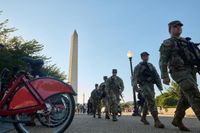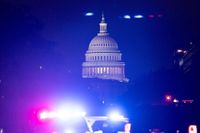In a dramatic and controversial effort to tackle crime in the nation’s capital, President Donald Trump’s administration has unleashed a sweeping federal crackdown on Washington, D.C., deploying thousands of National Guard troops and federal agents in a campaign that has led to a marked surge in arrests and a flurry of debate about public safety, civil liberties, and the future of local governance in the city.
Attorney General Pam Bondi announced Sunday that the number of arrests under the federal operation had climbed to 1,528, with 76 arrests made just on Saturday, August 30, 2025, during the busy Labor Day weekend. According to 7News, these arrests included two individuals accused of threatening law enforcement and one person who allegedly threatened to kill President Trump while assaulting a federal officer. Another notable arrest involved an undocumented immigrant accused of being an MS-13 gang member, a detail highlighted by both Bondi and President Trump in their public updates.
President Trump himself took to Truth Social to declare victory, posting, “DC IS NOW A CRIME FREE ZONE, IN JUST 12 DAYS!!!” In a follow-up, he touted daily updates: “This is a list I get every single day!” The president’s post for August 30 listed 76 arrests, five firearms seized, and highlighted arrests for violent offenses, including threats against the president and National Guard personnel as well as a sexual assault case. Trump’s declaration came just over two weeks after he invoked Section 740 of the District of Columbia Home Rule Act, placing the Metropolitan Police Department (MPD) under federal control and declaring a public safety emergency in the city.
To enforce the crackdown, Trump deployed around 800 National Guard troops to D.C., with 100 to 200 on duty at any given time. In a further escalation, states including West Virginia, Mississippi, Tennessee, Louisiana, South Carolina, and Ohio sent their own National Guard contingents, bringing the total to approximately 2,000 troops on the ground, as reported by Newsweek. Federal agents from agencies such as ICE, the FBI, Homeland Security Investigations (HSI), and the Secret Service were reassigned to patrol the city, joining forces with local police in a show of unprecedented federal authority.
The scale and intensity of the operation have been striking. Fox News reported that within the first 13 days, federal authorities logged around 550 arrests, with preliminary MPD data showing a 40% drop in robberies and auto break-ins. By August 24, the tally of arrests had surpassed 700, and 91 illegal firearms had been seized. As of August 31, Bondi’s figures put the total number of illegal guns confiscated at 156, reflecting a significant uptick in enforcement activity.
Some of the most dramatic incidents occurred in public view. According to Bloomberg, on a late Thursday in August, a 58-year-old man drew a “ghost gun”—a firearm built from parts with no serial number—during a heated argument on Georgia Avenue. The gun, loaded with one round in the chamber and 11 more in an extended magazine, was brandished in the open, underscoring the challenges law enforcement faces in curbing gun violence in the city.
Bondi’s statements have emphasized the collaboration between federal and local agencies. “This Labor Day weekend, our nation’s capital is a safer place thanks to our DC and Federal law enforcement partners,” she posted on X. Her statistics also noted that two arrests were made for threats against law enforcement, and one for assault on federal officers with threats to kill President Trump, alongside the arrest of the alleged MS-13 gang member.
Trump has been quick to claim credit for the apparent turnaround in crime rates. In a Truth Social post, he wrote, “DC is virtually, in just 14 days, a CRIME FREE ZONE. The people living and working there are ecstatic!!!” White House press secretary Karoline Leavitt echoed these sentiments, stating that total crime was down 19 percent and violent crime down 30 percent, adding that, “the model displayed in Washington can be replicated in other crime-ridden cities across the nation.”
Yet, the picture is not without its complications. The New York Times reported that while crime has fallen since the troop deployment, a significant portion of arrests have been for misdemeanor offenses. Newsweek cited MPD data showing a roughly 50 percent drop in violent crimes and an overall 40 percent drop in violent crime between August 7–30, 2025, compared to the same period in 2024. Carjackings dropped an eye-popping 82 percent—from 33 cases in 2024 to just six in 2025—while overall arrests increased by 24 percent and calls for assistance by 15 percent. Property crimes, however, saw a much smaller decline of about 11 percent, and the overall drop in total crime was pegged at 14 percent for the period.
Year-to-date, violent crime in D.C. has fallen by around 27 percent compared to 2024, with the most significant decreases in robberies and sex abuse cases. Property crimes dipped by about 5 percent, with burglary and arson down 22 percent and 33 percent, respectively. Still, some categories, like assault with a deadly weapon, remained virtually unchanged, and property crimes continued to make up the bulk of reported incidents.
These statistics have not silenced critics. Former White House press secretary Jen Psaki commented on X, “When kids are getting shot in their pews at a catholic school mass and your crime plan is to have national guard put mulch down around DC maybe rethink your strategy.” Representative Jasmine Crockett, a Texas Democrat, also voiced skepticism, suggesting that D.C. residents “aren’t ok with being the pawns that everyone else around Trump have decided to be.”
Meanwhile, the Justice Department under former President Joe Biden had reported in January 2025 that total violent crime in Washington, D.C., was already at its lowest level in over 30 years, according to MPD statistics. This historical context complicates the narrative of a city spiraling out of control prior to the federal intervention.
Despite the political back-and-forth, the data shows that the federal crackdown has led to a surge in arrests and a measurable decline in certain categories of crime, especially violent offenses and carjackings. As of now, National Guard troops are expected to remain in Washington, D.C., until the end of September, as authorities continue to monitor the situation and debate the long-term implications of such a robust federal presence in the capital.
For residents, business owners, and city officials alike, the coming weeks will be crucial in determining whether this aggressive approach to public safety brings lasting change—or simply a new set of challenges for the city’s future.

